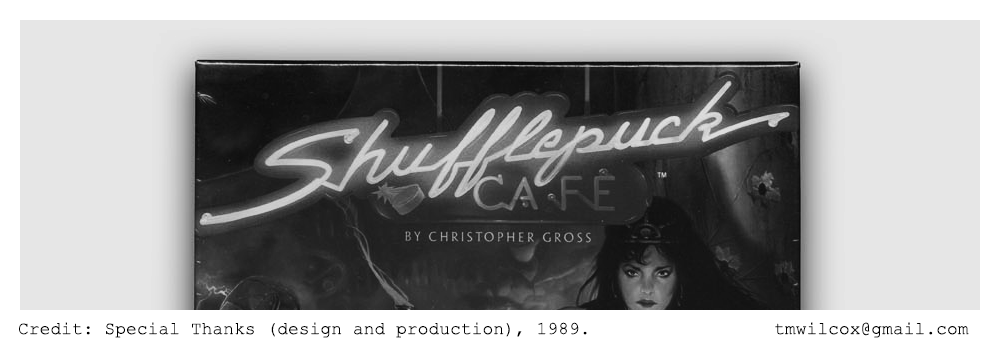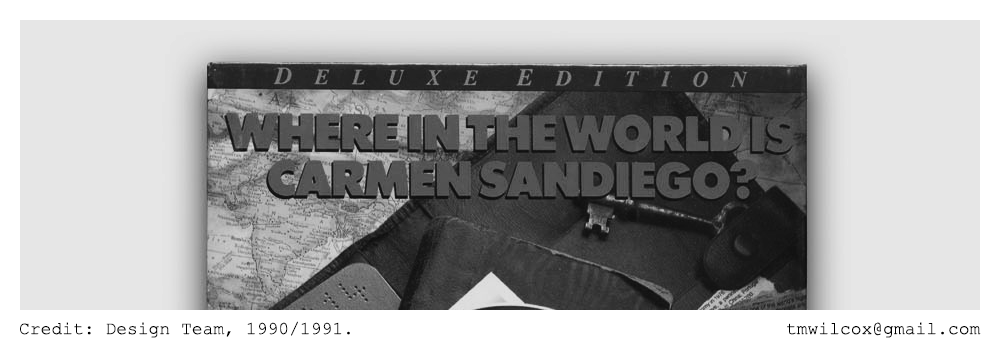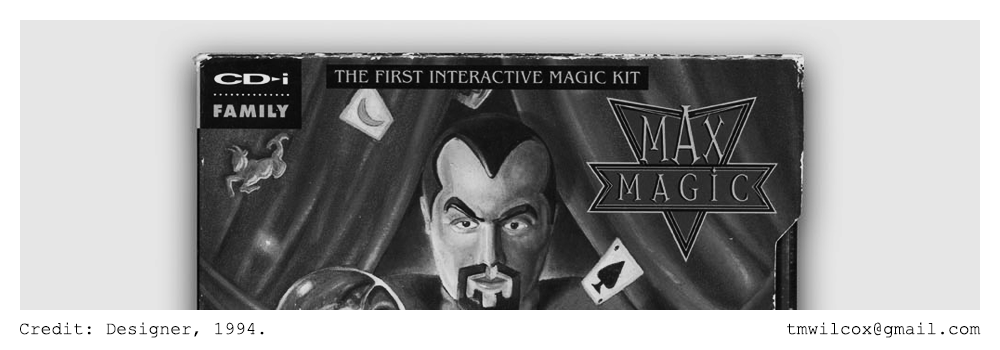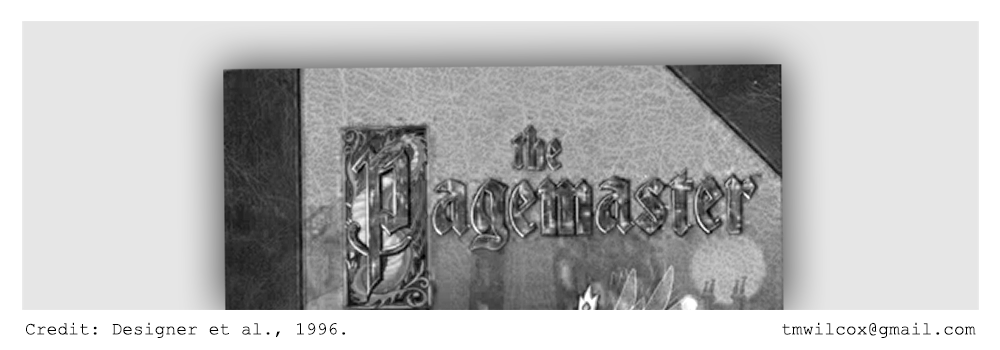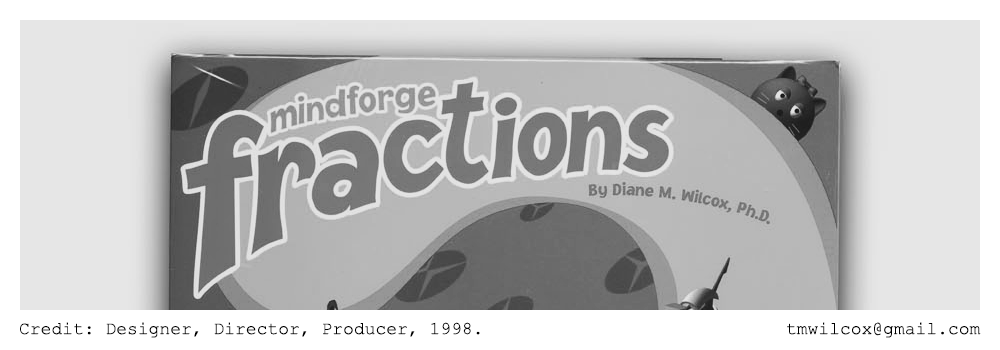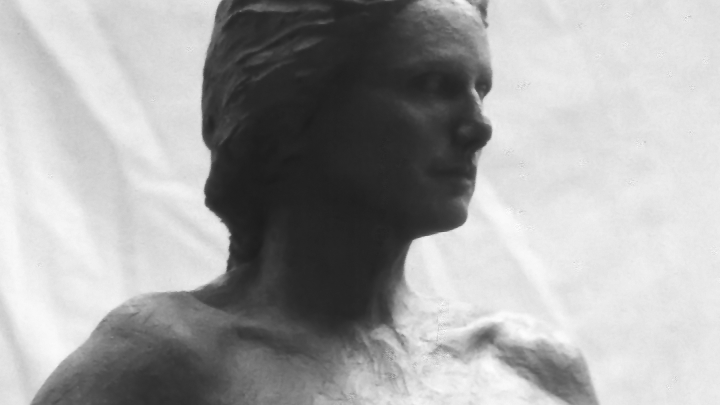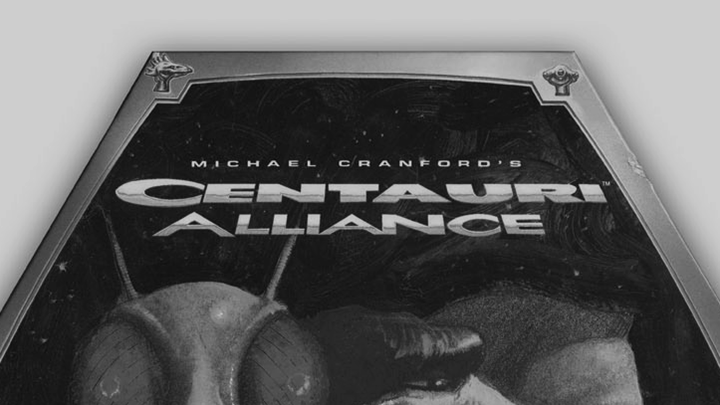
- CV Detail -
EARLY CAREER
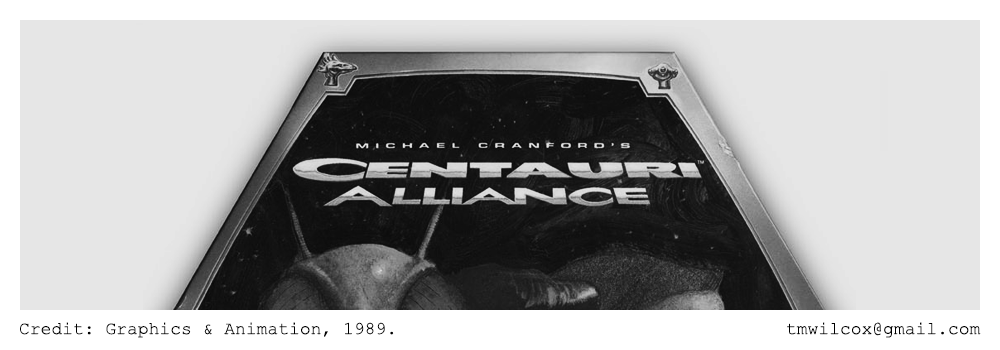
Setting aside studio art, I moved to the San Francisco Bay Area in 1987 looking for work in burgeoning computer graphics. I interviewed for a Game Artist position at a company in San Rafael called Broderbund Software. Admiring my figure drawing portfolio (PDF), they asked would I like making graphics and animation for a role‑playing game. I didn't draw comics or play computer games, but the prospect was intriguing. (Titles & Credits - "Centauri Alliance", 1989. Graphics and Animation: Tom Wilcox). See also "Centauri Alliance" (Moby Games).
Broderbund's bohemian culture was invigorating. For my effort as a model sheet artist, character animator, and level designer on "Centauri Alliance", they promoted me to Research And Development Artist while I redesigned "Shufflepuck Cafe" binary graphics for color Amiga and Apple IIGS computers. Simplifying cross-platform software development and porting, I adapted Truevision TARGA videographics cards with a novel device driver. For the first time, staff artists used TARGA-enabled PCs and multisync monitors to emulate multiple display types, switching video modes with a keystroke. (Titles & Credits - "Shufflepuck Cafe - Color Version for Amiga and Apple IIGS", 1989. Additional Graphic Design: Tom Wilcox) See also "Shufflepuck Cafe" (Wikipedia).
When Broderbund co-founder and CEO Doug Carlston asked how remaking the company's flagship product might exploit IBM's proposed high color Multimedia PC, I recommended alpha masks for overlaying digitized cel animation onto scanned photographs stylized with a kernel filter. Using the prerelease of a now popular raster graphics editor and an early multimedia authoring platform with a native scripting language, I demonstrated interface designs to team members with prototypes of Broderbund's award-winning and best-selling cultural geography game. Concepts presented in these rapidly developed applications inspired immediate changes that bypassed design document rewrites. Titles & Credits - "Where In The World Is Carmen SanDiego? Deluxe Edition", 1990. Design Team: Tom Wilcox et al.) See also "Where In The World Is Carmen SanDiego? Deluxe Edition" (Moby Games) and "Carmen Sandiego Deluxe Edition" (Wikipedia).
Broderbund created another position in 1990, promoting me to Project Designer while I developed the futuristic "Han Solo In Space" astronomy game prototype featuring rotoscoped characters from the Star Wars trilogy, digitized cutscenes from the movies, a first-person interface, and modified Carmen Sandiego gameplay. I found galaxy and solar system images at Bay Area universities using the Internet precursor, ARPANET. I processed Star Wars frame sequences for streaming over corporate Ethernet. The CEO invited executives from Apple Computer, Electronic Arts, and Sierra On-Line to view the prototype. The yearlong project ended when LucasArts renegotiated Broderbund's license. For the "Mark Twain's World" prototype, I hired a Hollywood screenwriter and a Marin County storyboard artist to assist with my branching dialog construction kit for role playing games. Broderbund cancelled that project, choosing a simpler concept for their literacy offering. By 1992, I was an independent contractor and the Designer of an eccentric magic kit developed by PF.Magic and published by Philips for their experimental CD‑i platform. With its real-time dialog and animation sequencing, the main character was recognized by the European Multimedia Association as the first software synthespian (virtual actor) to perform live in a computer game, earning the product an EMMA award for Best General Entertainment Title of 1994. In rehearsal mode, Max practices tricks with the player in a virtual teaching and learning environment. (Titles & Credits - "Max Magic", 1994. Designer: Tom Wilcox). See also "Max Magic" (Moby Games).
Hired as a Producer on "The Pagemaster CD‑ROM" project, I was also its initial Designer. I documented concepts for a first-person interface, a level editor, and a generative game challenge engine. I codeveloped art asset harvesting of animation cels at Hanna-Barbera in Burbank, and Turner Entertainment in Atlanta. With advice from a screenwriter on loan from Twentieth Century Studios, I authored branching dialog and backstory concepts at the game developer's Golden, Colorado office. From their Manhattan office, I pitched interactive storytelling to print publishers who insisted CD‑ROM was obsolete. (Titles & Credits - "The PageMaster", 1996. Designer: Tom Wilcox et al.) See also "The Pagemaster CD‑ROM" (Moby Games), and "The Pagemaster" fantasy-adventure film (Wikipedia).
I was a contract Interaction Designer while my partner was in graduate school at UNC Chapel Hill. Diane Wilcox was writing her dissertation when we launched Mindforge Inc. to publish educational software derived from the prototypes I created for her doctoral research in educational psychology. "Mindforge Fractions" broke new ground with its applied learning theory, a lavish video game-style interface, and fuzzy logic for student performance modeling and prediction with an inference engine. Without a competition component, "Mindforge Fractions" relies on both cognitive science and computer science to teach fundamental mathematics. (Titles & Credits - "Mindforge Fractions", 1998. Codesigner, Director, Producer: Tom Wilcox)
In 2000, I developed a reference design for the Colonial Williamsburg Foundation and their eponymous interactive media arm. The six part learning object about the American Revolutionary War augmented Children's Television Workshop programming, becoming the first PBS and broadband multimedia simulcast for elementary and secondary distance education. Designed for extensibility, "The April Conspiracy" was conceived as the pilot for a catalogue of Adobe Shockwave products. My last commercial contract was in 2007 when I authored role playing game concepts for Rosetta Stone Inc, a publisher of once ubiquitous language learning software. (Titles & Credits - "The April Conspiracy", 2001. Designer, Director, Programming, Graphics: Tom Wilcox). See also "Rosetta Stone" (Wikipedia).

Setting aside studio art, I moved to the San Francisco Bay Area in 1987 looking for work in burgeoning computer graphics. I interviewed for a Game Artist position at a company in San Rafael called Broderbund Software. Admiring my figure drawing portfolio (PDF), they asked would I like making graphics and animation for a role‑playing game. I didn't draw comics or play computer games, but the prospect was intriguing. (Titles & Credits - "Centauri Alliance", 1989. Graphics and Animation: Tom Wilcox). See also "Centauri Alliance" (Moby Games).
Broderbund's bohemian culture was invigorating. For my effort as a model sheet artist, character animator, and level designer on "Centauri Alliance", they promoted me to Research And Development Artist while I redesigned "Shufflepuck Cafe" binary graphics for color Amiga and Apple IIGS computers. Simplifying cross-platform software development and porting, I adapted Truevision TARGA videographics cards with a novel device driver. For the first time, staff artists used TARGA-enabled PCs and multisync monitors to emulate multiple display types, switching video modes with a keystroke. (Titles & Credits - "Shufflepuck Cafe - Color Version for Amiga and Apple IIGS", 1989. Additional Graphic Design: Tom Wilcox) See also "Shufflepuck Cafe" (Wikipedia).
When Broderbund co-founder and CEO Doug Carlston asked how remaking the company's flagship product might exploit IBM's proposed high color Multimedia PC, I recommended alpha masks for overlaying digitized cel animation onto scanned photographs stylized with a kernel filter. Using the prerelease of a now popular raster graphics editor and an early multimedia authoring platform with a native scripting language, I demonstrated interface designs to team members with prototypes of Broderbund's award-winning and best-selling cultural geography game. Concepts presented in these rapidly developed applications inspired immediate changes that bypassed design document rewrites. Titles & Credits - "Where In The World Is Carmen SanDiego? Deluxe Edition", 1990. Design Team: Tom Wilcox et al.) See also "Where In The World Is Carmen SanDiego? Deluxe Edition" (Moby Games) and "Carmen Sandiego Deluxe Edition" (Wikipedia).
Broderbund created another position in 1990, promoting me to Project Designer while I developed the futuristic "Han Solo In Space" astronomy game prototype featuring rotoscoped characters from the Star Wars trilogy, digitized cutscenes from the movies, a first-person interface, and modified Carmen Sandiego gameplay. I found galaxy and solar system images at Bay Area universities using the Internet precursor, ARPANET. I processed Star Wars frame sequences for streaming over corporate Ethernet. The CEO invited executives from Apple Computer, Electronic Arts, and Sierra On-Line to view the prototype. The yearlong project ended when LucasArts renegotiated Broderbund's license. For the "Mark Twain's World" prototype, I hired a Hollywood screenwriter and a Marin County storyboard artist to assist with my branching dialog construction kit for role playing games. Broderbund cancelled that project, choosing a simpler concept for their literacy offering. By 1992, I was an independent contractor and the Designer of an eccentric magic kit developed by PF.Magic and published by Philips for their experimental CD‑i platform. With its real-time dialog and animation sequencing, the main character was recognized by the European Multimedia Association as the first software synthespian (virtual actor) to perform live in a computer game, earning the product an EMMA award for Best General Entertainment Title of 1994. In rehearsal mode, Max practices tricks with the player in a virtual teaching and learning environment. (Titles & Credits - "Max Magic", 1994. Designer: Tom Wilcox). See also "Max Magic" (Moby Games).
Hired as a Producer on "The Pagemaster CD‑ROM" project, I was also its initial Designer. I documented concepts for a first-person interface, a level editor, and a generative game challenge engine. I codeveloped art asset harvesting of animation cels at Hanna-Barbera in Burbank, and Turner Entertainment in Atlanta. With advice from a screenwriter on loan from Twentieth Century Studios, I authored branching dialog and backstory concepts at the game developer's Golden, Colorado office. From their Manhattan office, I pitched interactive storytelling to print publishers who insisted CD‑ROM was obsolete. (Titles & Credits - "The PageMaster", 1996. Designer: Tom Wilcox et al.) See also "The Pagemaster CD‑ROM" (Moby Games), and "The Pagemaster" fantasy-adventure film (Wikipedia).
I was a contract Interaction Designer while my partner was in graduate school at UNC Chapel Hill. Diane Wilcox was writing her dissertation when we launched Mindforge Inc. to publish educational software derived from the prototypes I created for her doctoral research in educational psychology. "Mindforge Fractions" broke new ground with its applied learning theory, a lavish video game-style interface, and fuzzy logic for student performance modeling and prediction with an inference engine. Without a competition component, "Mindforge Fractions" relies on both cognitive science and computer science to teach fundamental mathematics. (Titles & Credits - "Mindforge Fractions", 1998. Codesigner, Director, Producer: Tom Wilcox)
In 2000, I developed a reference design for the Colonial Williamsburg Foundation and their eponymous interactive media arm. The six part learning object about the American Revolutionary War augmented Children's Television Workshop programming, becoming the first PBS and broadband multimedia simulcast for elementary and secondary distance education. Designed for extensibility, "The April Conspiracy" was conceived as the pilot for a catalogue of Adobe Shockwave products. My last commercial contract was in 2007 when I authored role playing game concepts for Rosetta Stone Inc, a publisher of once ubiquitous language learning software. (Titles & Credits - "The April Conspiracy", 2001. Designer, Director, Programming, Graphics: Tom Wilcox). See also "Rosetta Stone" (Wikipedia).
